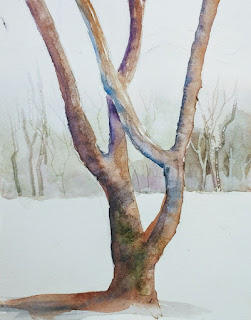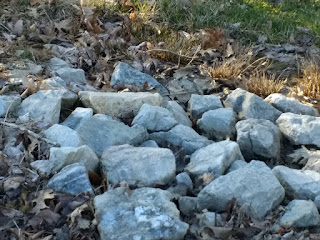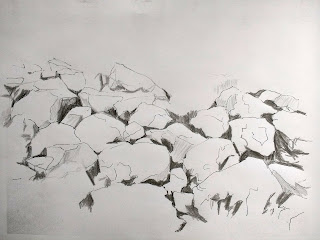NOT MUCH can ruin an otherwise beautiful painting more than a hokey looking tree. People (and I include myself in that category) sometimes have problems creating believable trees. Sometimes trees look like they are floating rather than anchored on the ground. Sometimes they look like they are growing out of someone's head or the roof of a building. Some look really cartoonish or the limbs look too thick at the top. Some foliage appears too solid and blocky, with no room "for the birds to fly through." How do you make distant trees? How can you make bark on a close-up?
I sent everyone some pictures of five views of the same tree. The first is front lit, and you can see how flattened the tree appears. The view gradually becomes more side lit, and the trunk appears more rounded because of the shadows on the trunk and branches. Finally you see a completely back-lit view, again completely flattening the tree. I prefer to paint some with strong shadows, but when doing a sunset, remember those trees are flattened.
Front-lit
Completely back-lit
The first thing we did was decide on a green that would work for the styles I wanted to demonstrate. Below is a picture of a "sample" page I made with different yellows and blues blended together. Phalo or cerulean and hansa yellow produced the most bright greens; cobalt and french ultramarine with yellows produced more subtle natural greens, and adding red or orange neutralized the color even further.
The first tree we tried was using a yellow and a blue with a hogs hair brush. You can read more about this technique in Gordon MacKenzie's Complete Watercolor Essential Notebook. This book was recommended by Steve Mitchell on his youtube channel, The Mind of Watercolor, and I've found it really useful.
The hogs hair brush is a stiff bristle, often called "chinese" brush, and used for oil painting. If used for watercolor, it holds a good amount of paint. In this method, apply yellow, following the foliage pattern of the tree, and while wet, putting blue beneath the yellow and allowing the paint to move up into the yellow. This creates the shadows of the tree. Be sure to leave spaces of sky. Continue to add darks in the shadow areas. If it is a pine tree, take a DRY hogs hair and drag the tips of the bristles over the ends to create the effect of pine needles.
Practice different types of trees, deciduous and evergreen. Use reference pictures (or observe trees) to see where the shadow areas of the leaves will go.
When dry, add the trunks of trees and a few carefully placed branches, being sure that the branches get smaller at the top.
Deciduous, applied with hogs hair brush
Evergreen, using hogs hair bristles for pine needles
The next method we tried was using sponging for the foliage. This can be effective or it can look contrived. Gordon Mackenzie TEARS a cellulose sponge into small pieces. Then he soaks up paint with the sponge, squeezes it out, then soaks it up again. He applies the yellow for the sunlit top side, then the blue for the shadowed side. I liked the look, but it felt like it used a lot of paint into the sponge.
Here is another sponging technique for a lot of trees in a scene.
You might recognize the picture below. In this one, the entire tree line was sponged in yellows and oranges added while wet. Once it dried I sponged in some greens and blues for the darker trees, and added some negative painting for more tree trunks.
Next we practiced using a PALETTE KNIFE or CREDIT CARD to paint limbs and small branches.
There is a bit of a trick to this. The consistency of the paint should be like ink: thick enough to stick to the palette knife, but runny enough to flow off the knife smoothly. At first I thought it had to be a metal knife, but the plastic ones work also, especially those with a wide blade shaped like a trapezoid. Load the flat part of the palette knife with paint. Hold the blade almost vertically, and pull it across the paper quickly to create small branches. They will look very branch-like, with jagged edges. It takes a bit of practice, but it's not a big learning curve.
Now try this with a credit card. I cut mine at a diagonal so that I have one sharp point, one rounded part, and all edges are a different length. Drag the card through the puddle of paint so that some sticks to one flat side. Use the point to make some branches. Drag it through the puddle again, and now try using one of the flat sides to make a trunk. You hold the side of the credit card onto the paper and pull horizontally to make a trunk that looks like a birch tree.
Finally we put it all together with this picture of a tree a took at a local park. It has a lot in it to practice: distant trees, aerial perspective, shadowing, texture on the bark, and anchoring the base of the tree to the ground.
For the background trees, wet the area from the horizon line to about an inch above where you want to put the top of the trees. Working wet into wet, add some pale neutral purple or blue at the top, then some neutral greens until the area is covered. While the paint is still shiny, you can use the point of the credit card to pull out some thing trees. (It creates a dent in the paper that paint gravitates too, making it darker than the area around it.) You can add green with a flat brush held vertically to suggest fir trees. When the paint loses its sheen, but is still damp, use the round part of the credit card or a tip of a palette knife to scrape out white trees and branches. And when it is dry, practice pulling out some branches with some negative painting.

For the trunk you can mix any two complimentary colors to get a brown you like. On this tree I began with burnt sienna on one side and French ultramarine on the left side.(shadowed side), and let them blend together on the paper. I liked the strong shadow in this picture and tried to reinforce it. I wanted it to appear to have some moss on the trunk bottom, so I introduced some deep green (mixed from French and gamboge), and sponged it on the edges.
There are three things that help anchor a tree to it's surroundings: keeping the value similar where the trunk and ground meet; shadows that connect the trunk to the ground; and soft edges. You can see that I softened the edge where the trunk and ground meet. The shadow on the left side of the tree melts into the shadow on the gorund. And the values are very similar.
This was a practice picture, not meant to be a final product, but do show ways you can achieve a natural looking tree.
WHEW! We covered a lot, and there is so much more we could have tried. Trees can add a lot to your picture. They don't have to be photorealistic to be believable. They do have to match the style of your painting, though, and I hope these tips are useful to you!
Next time: adding ROCKS to your painting.























